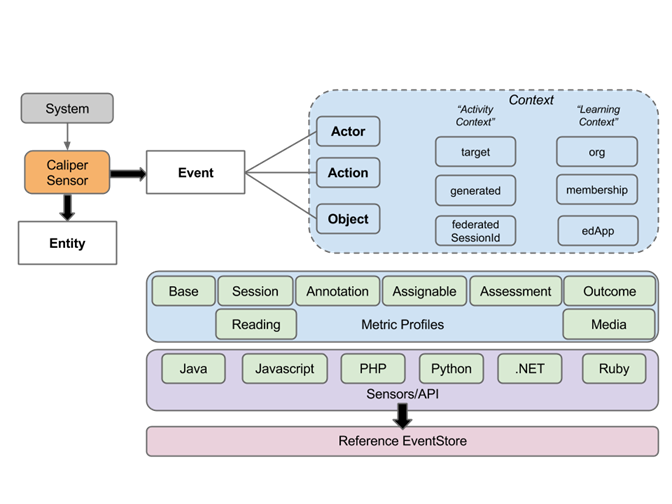
The advent of xAPI (ADL) was not an unexpected event. TinCan was discussed for a very long time, a huge number of open forums were "in full swing" when discussing the new specification. It was only after sufficient discussion that ADL released the specification. Then, after the practical work of many companies with xApi, CMI5 appeared.
And then a similar specification from the IMS Global Learning Consortium called Caliper appeared.
The marked similarities between xAPI and Caliper have prompted developers and content providers to clarify the differences in implementation of one or both of the specifications (both of which are currently aimed at standardization).
Both xAPI and Caliper supporting communities expressed concern about the cost-effective support of both specifications, which led to requests for both ADL and IMS whether harmonization is possible.
Here is a short answer "IMS" ( link )
a) Caliper and xAPI have very different origins. The core xAPI is to enable any type of experience and evidence tracking, both electronic and physical performance and not limited to just web-based courses (as is the case for SCORM). Caliper is the manifestation of the IMS Learning Analytics Framework and the Sensor API and Metric Profile (s) are the first two components of that framework. xAPI and Caliper are NOT equivalent. Adoption should not be 'one-or-the-other', instead it is a 'horses-for-courses' decision;
b) While both xAPI (Actor / Verb / Object) and Caliper (Actor / Action / Activity) use a data model based upon a triple statement structure there are significant differences in the detailed structure and usage of the Object and Activity definitions. However, it should be possible for each specification to make use of the other's Verb / Action;
Here is the short answer "ADL" ( link ).
As xAPI has matured, so too has a similar specification from the IMS Global Learning Consortium called Caliper. There are notable similarities between xAPI and Caliper, which has caused adopters and vendors to clarify implementation differences of one or both specifications (both of which are now targeting standardization). Both communities supporting xAPI and Caliper have expressed concerns about being able to cost-effectively support both specs, which led to inquiries to both ADL Initiative and IMS about whether alignment of the two would be possible.
xAPI (Actor / Verb / Object) and Caliper (Actor / Action / Activity) use a data model based on the ternary operator structure, there are significant differences in the detailed structure and usage of Object and Activity definitions. Apparently Actor and Verb / Action are the same, only Object / Activity differ?
I have been working with xAPI for quite some time, but Caliper was not familiar to me. I had to study the documentation a little ( link and one more ).
I will say right away that I did not find any significant differences for me personally. What is called in the xAPI statement (Activites) is called Event in Caliper.


I drew attention to the presence of the so-called "metric" in Caliper, but the description is rather abstract, I could not find examples of practical use.
The Caliper information model defines a number of metric profiles, each of which models a learning activity or a supporting activity that helps facilitate learning. A metric profile’s raison d’etre is to encourage vocabulary standardization and re-use among application providers delivering complementary, albeit competing capabilities that collect learning activity data. Each profile provides a domain-specific set of terms and concepts that application designers and developers can draw upon to describe common user interactions in a consistent manner using a shared vocabulary. Annotating a reading, playing a video, taking a test, or grading an assignment submission represent a few examples of the many activities or events that Caliper’s metric profiles attempt to describe.
Think of each metric profile as a stand-alone, logical container, or collection of one or more Caliper events that together help describe describe a set of inter-related activities. Each Event type included in a metric profile place constraints on the various entities and actions that can be utilized to describe a learning activity. Vocabulary restrictions are outlined in each profile description under the following headings
There are a lot of “pretty pictures” on the IMS website, but they further enhance the feeling that the difference is minimal.
From the point of view of the authorization and storage mechanism (LRS), there is practically no difference, the difference between JSON in xApi and JSON-LD in Caliper is not significant for me. those. and there is no difference in these matters.
Let's see examples of JSON xApi and Caliper
xApi
{
"actor": {
"name": "Sally Glider",
"mbox": "mailto:sally@example.com"
},
"verb": {
"id": "http://adlnet.gov/expapi/verbs/completed",
"display": { "en-US": "completed" }
},
"object": {
"id": "http://example.com/activities/hang-gliding-test",
"definition": {
"type": "http://adlnet.gov/expapi/activities/assessment",
"name": { "en-US": "Hang Gliding Test" },
"description": {
"en-US": "The Solo Hang Gliding test, consisting of a timed flight from the peak of Mount Magazine"
},
"extensions": {
"http://example.com/gliderClubId": "test-435"
}
}
},
"result": {
"completion": true,
"success": true,
"score": {
"scaled": 0.95
},
"extensions": {
"http://example.com/flight/averagePitch": 0.05
}
},
"context": {
"instructor": {
"name": "Irene Instructor",
"mbox": "mailto:irene@example.com"
},
"contextActivities":{
"parent": { "id": "http://example.com/activities/hang-gliding-class-a" }
"grouping": { "id": "http://example.com/activities/hang-gliding-school" }
},
"extensions": {
"http://example.com/weatherConditions": "rainy"
}
},
"timestamp": "2012-07-05T18:30:32.360Z",
"stored": "2012-07-05T18:30:33.540Z",
"authority": {
"name": "Irene Instructor",
"mbox": "mailto:irene@example.com"
}
}Caliper
{
"sensor": "https://example.edu/sensors/1",
"sendTime": "2018-11-15T11:05:01.000Z",
"dataVersion": "http://purl.imsglobal.org/ctx/caliper/v1p1",
"data": [
{
"@context": "http://purl.imsglobal.org/ctx/caliper/v1p1",
"id": "https://example.edu/users/554433",
"type": "Person",
"dateCreated": "2018-08-01T06:00:00.000Z",
"dateModified": "2018-09-02T11:30:00.000Z"
},
{
"@context": "http://purl.imsglobal.org/ctx/caliper/v1p1",
"id": "https://example.edu/terms/201801/courses/7/sections/1/assess/1?ver=v1p0",
"type": "Assessment",
"name": "Quiz One",
"items": [
{
"id": "https://example.edu/terms/201801/courses/7/sections/1/assess/1/items/1",
"type": "AssessmentItem"
},
{
"id": "https://example.edu/terms/201801/courses/7/sections/1/assess/1/items/2",
"type": "AssessmentItem"
},
{
"id": "https://example.edu/terms/201801/courses/7/sections/1/assess/1/items/3",
"type": "AssessmentItem"
}
],
"dateCreated": "2018-08-01T06:00:00.000Z",
"dateModified": "2018-09-02T11:30:00.000Z",
"datePublished": "2018-08-15T09:30:00.000Z",
"dateToActivate": "2018-08-16T05:00:00.000Z",
"dateToShow": "2018-08-16T05:00:00.000Z",
"dateToStartOn": "2018-08-16T05:00:00.000Z",
"dateToSubmit": "2018-09-28T11:59:59.000Z",
"maxAttempts": 2,
"maxScore": 15.0,
"maxSubmits": 2,
"version": "1.0"
},
{
"@context": "http://purl.imsglobal.org/ctx/caliper/v1p1",
"id": "https://example.edu",
"type": "SoftwareApplication",
"version": "v2"
},
{
"@context": "http://purl.imsglobal.org/ctx/caliper/v1p1",
"id": "https://example.edu/terms/201801/courses/7/sections/1",
"type": "CourseSection",
"academicSession": "Fall 2018",
"courseNumber": "CPS 435-01",
"name": "CPS 435 Learning Analytics, Section 01",
"category": "seminar",
"subOrganizationOf": {
"id": "https://example.edu/terms/201801/courses/7",
"type": "CourseOffering",
"courseNumber": "CPS 435"
},
"dateCreated": "2018-08-01T06:00:00.000Z"
},
{
"@context": "http://purl.imsglobal.org/ctx/caliper/v1p1",
"id": "urn:uuid:c51570e4-f8ed-4c18-bb3a-dfe51b2cc594",
"type": "AssessmentEvent",
"actor": "https://example.edu/users/554433",
"action": "Started",
"object": "https://example.edu/terms/201801/courses/7/sections/1/assess/1?ver=v1p0",
"generated": {
"id": "https://example.edu/terms/201801/courses/7/sections/1/assess/1/users/554433/attempts/1",
"type": "Attempt",
"assignee": "https://example.edu/users/554433",
"assignable": "https://example.edu/terms/201801/courses/7/sections/1/assess/1?ver=v1p0",
"count": 1,
"dateCreated": "2018-11-15T10:15:00.000Z",
"startedAtTime": "2018-11-15T10:15:00.000Z"
},
"eventTime": "2018-11-15T10:15:00.000Z",
"edApp": "https://example.edu",
"group": "https://example.edu/terms/201801/courses/7/sections/1",
"membership": {
"id": "https://example.edu/terms/201801/courses/7/sections/1/rosters/1",
"type": "Membership",
"member": "https://example.edu/users/554433",
"organization": "https://example.edu/terms/201801/courses/7/sections/1",
"roles": [ "Learner" ],
"status": "Active",
"dateCreated": "2018-08-01T06:00:00.000Z"
},
"session": {
"id": "https://example.edu/sessions/1f6442a482de72ea6ad134943812bff564a76259",
"type": "Session",
"startedAtTime": "2018-11-15T10:00:00.000Z"
}
},
{
"@context": "http://purl.imsglobal.org/ctx/caliper/v1p1",
"id": "urn:uuid:dad88464-0c20-4a19-a1ba-ddf2f9c3ff33",
"type": "AssessmentEvent",
"actor": "https://example.edu/users/554433",
"action": "Submitted",
"object": "https://example.edu/terms/201801/courses/7/sections/1/assess/1?ver=v1p0",
"generated": {
"id": "https://example.edu/terms/201801/courses/7/sections/1/assess/1/users/554433/attempts/1",
"type": "Attempt",
"assignee": "https://example.edu/users/554433",
"assignable": "https://example.edu/terms/201801/courses/7/sections/1/assess/1?ver=v1p0",
"count": 1,
"dateCreated": "2018-11-15T10:15:00.000Z",
"startedAtTime": "2018-11-15T10:15:00.000Z",
"endedAtTime": "2018-11-15T10:55:12.000Z",
"duration": "PT40M12S"
},
"eventTime": "2018-11-15T10:25:30.000Z",
"edApp": "https://example.edu",
"group": "https://example.edu/terms/201801/courses/7/sections/1",
"membership": {
"id": "https://example.edu/terms/201801/courses/7/sections/1/rosters/1",
"type": "Membership",
"member": "https://example.edu/users/554433",
"organization": "https://example.edu/terms/201801/courses/7/sections/1",
"roles": ["Learner"],
"status": "Active",
"dateCreated": "2018-08-01T06:00:00.000Z"
},
"session": {
"id": "https://example.edu/sessions/1f6442a482de72ea6ad134943812bff564a76259",
"type": "Session",
"startedAtTime": "2018-11-15T10:00:00.000Z"
}
},
{
"@context": "http://purl.imsglobal.org/ctx/caliper/v1p1",
"id": "urn:uuid:a50ca17f-5971-47bb-8fca-4e6e6879001d",
"type": "GradeEvent",
"actor": {
"id": "https://example.edu/autograder",
"type": "SoftwareApplication",
"version": "v2"
},
"action": "Graded",
"object": {
"id": "https://example.edu/terms/201801/courses/7/sections/1/assess/1/users/554433/attempts/1",
"type": "Attempt",
"assignee": "https://example.edu/users/554433",
"assignable": "https://example.edu/terms/201801/courses/7/sections/1/assess/1?ver=v1p0",
"count": 1,
"dateCreated": "2018-11-15T10:15:00.000Z",
"startedAtTime": "2018-11-15T10:15:00.000Z",
"endedAtTime": "2018-11-15T10:55:12.000Z",
"duration": "PT40M12S"
},
"eventTime": "2018-11-15T10:57:06.000Z",
"edApp": "https://example.edu",
"generated": {
"id": "https://example.edu/terms/201801/courses/7/sections/1/assess/1/users/554433/attempts/1/scores/1",
"type": "Score",
"attempt": "https://example.edu/terms/201801/courses/7/sections/1/assess/1/users/554433/attempts/1",
"maxScore": 15.0,
"scoreGiven": 10.0,
"scoredBy": "https://example.edu/autograder",
"comment": "auto-graded exam",
"dateCreated": "2018-11-15T10:56:00.000Z"
},
"group": "https://example.edu/terms/201801/courses/7/sections/1"
}
]
}I must admit that I have not been able to identify for myself a significant difference between these specifications.
Phrase
IMS Learning Analytics Framework and the Sensor API and Metric Profile (s) are the first two components of that frameworksays that apparently we should expect the appearance of the Framework. But I could not find information on it.
I do not know the reasons why the two respected organizations presented, in my personal opinion, similar specifications. Previous history of SCORM (ADL) and IMS CP “coexistence”, for example, showed that standards can complement each other. This time I do not see such an addition.